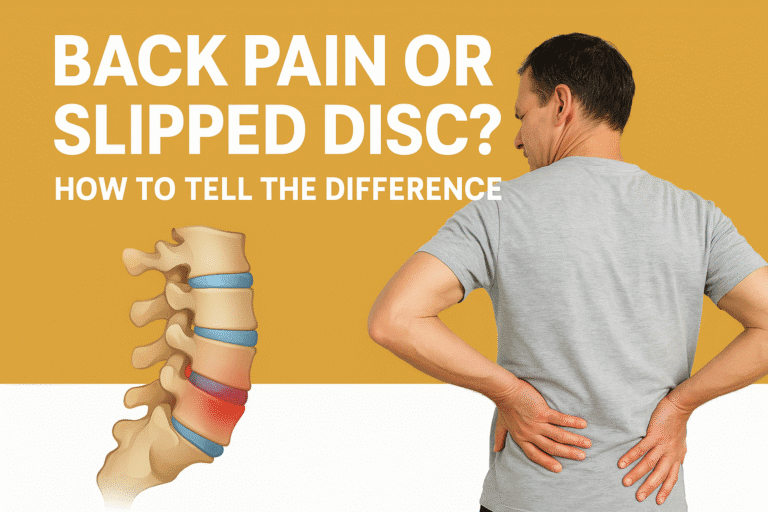Dr. Mrugank Narvekar
MBBS, MS(ORTHO), FISS, F.AOSPINE
Back Pain or Slipped Disc?? : How to Tell the Difference

Back pain is one of the most common health problems today, affecting people of all ages — from young professionals sitting long hours to older adults with degenerative spine changes.
But not all back pain is the same. Many patients wonder whether their pain is just muscular strain or a more serious slipped disc (herniated disc). Understanding the difference is key to getting the right treatment and avoiding long-term complications.
In this blog, Dr. Mrugank Narvekar, an orthopaedic spine surgeon in Mumbai, explains how to tell the difference between regular back pain and a slipped disc, what symptoms to watch for, and when to seek medical help.
What Is Regular Back Pain?
Back pain can arise from multiple causes, including muscle strain, ligament injury, poor posture, or lack of exercise.
This type of pain usually:
- Feels dull, stiff, or achy.
- Gets worse after sitting or standing for long periods.
- Improves with rest, gentle stretching, or over-the-counter pain relief.
Most mechanical back pain is temporary and improves within a few days to weeks with proper posture correction and simple exercises.
What Is a Slipped Disc?
A slipped disc, also known as a herniated disc, occurs when the soft inner portion of an intervertebral disc bulges out through its outer layer. This can irritate or compress nearby spinal nerves, leading to pain that radiates beyond the back.
Common causes include:
- Lifting heavy objects incorrectly
- Sudden twisting movements
- Age-related disc degeneration
- Prolonged poor posture or sitting habits
Back Pain vs Slipped Disc : The Key Differences
| Feature | Simple Back Pain | Slipped Disc (Herniated Disc) |
|---|---|---|
| Pain Location | Localized to the back | Radiates to leg or arm |
| Pain Type | Dull ache, stiffness | Sharp, shooting, or burning pain |
| Associated Symptoms | Muscle tightness | Numbness, tingling, or weakness |
| Aggravating Factors | Poor posture, inactivity | Coughing, sneezing, bending |
| Relief With Rest | Usually improves | Often persists or worsens |
If you experience pain radiating to your legs (sciatica), or numbness and weakness, there’s a strong possibility of a slipped disc that requires medical evaluation.
When Should You See a Spine Specialist?
You should consult a spine surgeon if you experience:
- Pain lasting more than two weeks
- Numbness or tingling in the legs or feet
- Pain radiating below the knee or into the arm
- Weakness while walking or holding objects
- Difficulty controlling bladder or bowel movements (medical emergency)
Early diagnosis and treatment prevent worsening nerve compression and long-term damage.
Diagnosis of Slipped Disc
Your doctor may recommend:
- MRI scan – to visualize disc herniation and nerve involvement
- X-rays – to rule out bone-related issues
- Neurological examination – to assess nerve function and muscle strength
Treatment Options
Treatment depends on the severity of symptoms and the degree of disc herniation.
Non-surgical treatments include:
- Rest and physiotherapy
- Anti-inflammatory medications
- Posture training and core-strengthening exercises
- Epidural steroid injections (for nerve pain relief)
If symptoms persist despite conservative treatment, minimally invasive or endoscopic spine surgery may be advised to remove the herniated disc portion and relieve nerve pressure.
Preventing Back Pain and Slipped Disc
Simple lifestyle changes can protect your spine:
- Maintain correct posture while sitting and lifting
- Stay active and strengthen your core muscles
- Avoid prolonged sitting without breaks
- Maintain a healthy body weight
- Sleep on a supportive mattress
Conclusion
While most back pain is harmless and temporary, a slipped disc requires prompt attention. The key is accurate diagnosis and timely treatment.
If you are experiencing persistent back or leg pain, consult Dr. Mrugank Narvekar, one of Mumbai’s leading orthopaedic spine surgeons, for a personalized evaluation and treatment plan.
